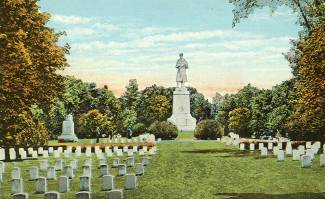Collection Name
About
Black soldiers buried separately at Antietam
Officials seek information
SHARPSBURG (AP) — Eight black soldiers who served in the two World Wars are buried in the back corner of the Antietam National Cemetery, separated from their white contemporaries because of segregation.
A few names are barely legible on the weathered headstones: Pfc. Howard S. Puller of West Virginia; Sgt. Littleton Goens of Maryland; Lee I. Lavender, a cook.
The soldiers were buried at Antietam in the 1930s and 1940s so they would be away from their comrades under U.S. laws that separated people on the basis of race or ethnicity, said John Howard, the cemetery's superintendent.
"This separation, even in death, is the greatest irony that we can show people — the fact that this was occurring some years after the war ended here at the battle that was to free all men," Howard said.
The armed services weren't desegregated until 1948, when President Truman issued an executive order ending racial segregation in the United States military forces.
The National Park Service is trying to find out more about the soldiers, who Howard said have never received visits or inquiries from family members or friends during his 10 years at the cemetery.
"We're not even sure exactly how they ended up here," Howard said. "We know what divisions they served in, but we want to find out more about them."
Antietam National Cemetery was established in 1862 as a burial place for Union and Confederate soldiers killed in the bloodiest single-day battle in U.S. history.
"There were 23,110 causalities killed and wounded," Howard said. "That's about one soldier for every second that the fighting went on."
Following the battle, which took place on Sept. 17, 1862, President Lincoln issued the Emancipation Proclamation, which freed slaves in the South.
The segregated burial sites for black World War I and World War II soldiers reflect a nation deeply divided along racial lines, cemetery historian Ted Alexander said.
"This country was still grappling with these issues long after fighting a bloody Civil War," Alexander said. "These soldiers were among troops of all races to fight in World War I, the war meant to save Democracy and end all wars."
The cemetery has more than 5,000 soldiers killed in the Civil War, the Spanish-American War, the Korean War, World War I, World War II and one soldier killed in the 2000 terrorist attack on the USS Cole, Alexander said.
Used with permission of The Associated Press © 2007 All Rights Reserved.
Printed in the Cumberland Times-News
The postcard of Antietam National Cemetery is from a postcard from the collection of Albert and Angela Feldstein.
